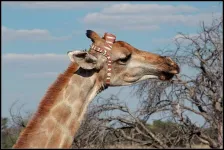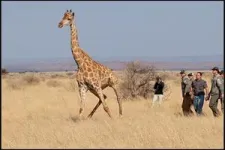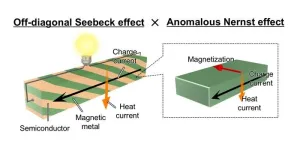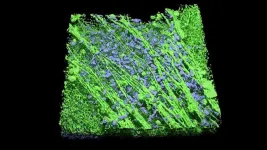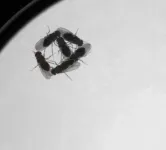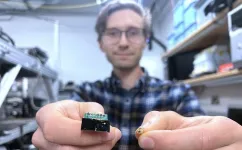(Press-News.org) New research finds that giraffes much prefer flat terrain and do not traverse slopes of more than 20°, which severely limits the areas in, and outside, protected reserves they can access. The findings, which is are yet to be published, will be presented at the British Ecological Society’s (BES) Annual meeting in Liverpool on the 13th December.
A new study analysing the movements of 33 GPS collared giraffes in South Africa has found that they avoid steep terrain and are unable to navigate slopes with a gradient of more than 20° , most likely due to the energy required and the risk of falling.
The researchers from the University of Manchester and the University of the Free State, South Africa found that giraffes will tolerate terrain of up to 12°, but only if it leads to favourable vegetation.
Jessica Granweiler, a PHD candidate at the University of Manchester, who will present this research at the BES Annual Meeting said “We often think of giraffes roaming in large, flat grassland savannas in Africa, but that's not really their true habitat, there are also rolling hills, deep riverbeds and high plateaus.
“Our study shows that giraffes much prefer flat areas. They will tolerate some steepness to access food, but simply cannot access areas above a 20° gradient. It's quite shocking when you look at distribution maps.”
“Giraffes are tolerant animals and resilient to many things like food availability and human pressures, but this is a scenario where they simply may not be able to adapt due to physiological limits.”
The findings highlight a mismatch between the ideal, flat habitats of giraffes and the areas they’re being conserved in. Using the newly discovered 20° gradient threshold, the researchers were able to calculate the proportion of habitats in key African countries where giraffes are currently found that are inaccessible to the animals.
“In Namibia and Tanzania, there is approximately 8,000km2 that may be unusable to giraffes, that’s nearly half of the size of Wales.” said Jessica. “In Kenya and South Africa, there’s approximately 4,000km2 that may be unusable. What’s even more worrying is that of all the countries we mapped, one in three had more unusable areas in protected areas than outside of protected areas.”
This issue is exacerbated when reserves are fenced, which many in South Africa are. “If a reserve is say 200 hectares but has a large mountain in the middle, from a giraffe’s perspective, this reserve is not 200 hectares anymore.” said Jessica. “We need to start including topography in giraffe conservation planning and habitat assessments, especially for small fenced reserves.”
Professor Susanne Shultz, lead supervisor on Jessica’s PHD, further commented: “Steep and rugged environments are challenging for large-bodied animals, like giraffes. Unfortunately, natural and protected areas are more likely to be placed in such places, which can lead to a mismatch between the landscapes animals ‘want’ to use and the landscapes that we have ‘left’ for them. Incorporating geography and physical limitations in habitat assessments can help avoid conserving animals in inappropriate places.”
Giraffes are currently found in 21 African countries but despite their wide distribution, populations have been declining due to habitat loss, poaching, and human-wildlife conflict. Conservation initiatives are critical for their survival. However, traditional habitat suitability models primarily focus on vegetation distribution, predation, and human disturbance and overlook topography.
In the study, the researchers repurposed GPS data collected between 2011 to 2023 by Dr Francois Deacon’s team at the University of the Free State, South Africa who fitted GPS collars to 33 giraffes (10 males and 23 females) across five reserves in South Africa. The researchers combined this data with topographic maps to work out the gradients that giraffes could and couldn’t navigate.
Dr Francois Deacon, who was also part of this research said "The more awareness we can bring to giraffe ecology, the more research effort there will be on this species in the future. The fact that we are still discovering major limitations or drivers of their ecology and behaviour is worrying. But research like ours helps closing this gap in knowledge and will help better management and conservation of giraffes in the future."
-ENDS-
END
1. A research team from NIMS and UTokyo has proposed and demonstrated that the transverse magneto-thermoelectric conversion in magnetic materials can be utilized with much higher performance than previously by developing artificial materials comprising alternately and obliquely stacked multilayers of a magnetic metal and semiconductor.
2. When a temperature gradient is applied to a magnetic conductor, a charge current is generated in a direction orthogonal to directions of both temperature gradient and magnetization of the magnetic conductor. This transverse magneto-thermoelectric phenomenon, ...
-With images-
Durham University scientists have made a groundbreaking discovery in marine geoscience, revealing unprecedented insights into the dynamics of Earth’s longest runout sediment flows.
By using seabed seismographs placed safely outside the destructive paths of powerful underwater avalanches of sediment, researchers have successfully monitored turbidity currents—a natural phenomenon that shapes deep-sea landscapes, damages telecommunication cables, and transports large quantities of sediment and organic carbon to the ocean floor.
The study recorded two massive turbidity ...
Despite awe-inspiring diversity, nearly every lifeform – from bacteria to blue whales – shares the same genetic code. How and when this code came about has been the subject of much scientific controversy.
Taking a fresh approach at an old problem, Sawsan Wehbi, a doctoral student in the Genetics Graduate Interdisciplinary Program at the University of Arizona, discovered strong evidence that the textbook version of how the universal genetic code evolved needs revision. Wehbi is the first author of a study published in the journal PNAS suggesting the order with which amino acids – the code's building blocks –
were recruited is at odds with ...
A program designed to prepare future teachers and K-12 students for a lifetime of innovation recently received a $572,890 boost from the National Science Foundation.
The ChangeMaker K-12 program, designed by faculty from the University of Louisiana at Lafayette’s College of Education & Human Development, received a second round of grant funding to expand the teacher prep program to other universities. The new partners are the University of Louisiana Monroe, Louisiana Tech University and the University of Hawaii at Manoa.
The project is led by Dr. Doug Williams, director of UL Lafayette’s Center for Innovative Learning and Assessment Technologies, along with Dr. Aimee Barber, ...
A team of researchers at USC and the University of Utah has received a $2.7 million grant from the National Institutes of Health to map out how an incurable eye disease affects the wiring that powers vision in the eye, in hopes of discovering ways to slow or prevent blindness. Retinitis pigmentosa (RP) is a progressive disease with four known stages that affects the retina, the area at the back of the eye where light is turned into electrical signals that the brain processes to produce sight. The research ...
AI will soon receive a dose of empathy with the goal of helping to match people with depression to their best-fit medication. A team led by Farrokh Alemi, a professor in the College of Public Health (CPH), and Kevin Lybarger, an assistant professor in the College of Engineering and Computing (CEC), received $1,049,998 in research funding from the Patient-Centered Outcomes Research Institute (PCORI) to continue their work on developing an AI system that helps patients find the right depression medications.
With this funding support, Co-PIs Alemi and Lybarger will hone large language models (LLMs) to address known challenges in ...
CHAMPAIGN, Ill. — The Midwest played a central role in the growth of Black freedom movements in the 20th century. It was a key site for incubating and expanding the ideas of political activist Marcus Garvey, not only in the U.S., but globally, said University of Illinois Urbana-Champaign professor of African American studies and history Erik S. McDuffie.
McDuffie examined the influence of Garvey and the importance of the Midwest in the growth of Black internationalism and radicalism in his new book, “The Second Battle for Africa: Garveyism, the U.S. Heartland and Global Black Freedom.”
McDuffie ...
In most research labs, the scientists are on the same page about why they’re pursuing a research project.
But the Rubin Lab at HHMI's Janelia Research Campus isn’t an ordinary research lab.
The lab is examining how aggression affects vision in female fruit flies, but Janelia Senior Group Leader Gerry Rubin doesn’t care too much about the specific answer. Instead, he simply wants to see if the neuroscience research tools that he spent the last decade building are adequate to uncover the underlying mechanisms at play.
Postdoc Katie Schretter, on the other hand, is interested in understanding how neurons in the fly brain ...
HOUSTON, Dec. 12 2024 – A group of ambitious students from the University of Houston and Texas A&M University, identifying as the “Dream Team,” secured third place in the prestigious global Switch Competition. This annual virtual event, sponsored by the Switch Energy Alliance, challenges university students to develop innovative solutions for addressing energy poverty worldwide — a critical issue affecting millions.
The team is comprised of Sarah Grace Kimberly and Pranjal Sheth, both senior finance majors at UH, and Nathan Hazlett, a finance graduate student at A&M who previously earned a bachelor’s degree in petroleum engineering. Competing ...
For experiments that require ultra-precise measurements and control over atoms — think two-photon atomic clocks, cold-atom interferometer sensors and quantum gates — lasers are the technology of choice, the more spectrally pure (emitting a single color/frequency), the better. Conventional lab-scale laser technology currently achieves this ultra low-noise, stable light via bulky, costly tabletop systems designed to generate, harness and emit photons within a narrow spectral range.
But what if these atomic applications ...
